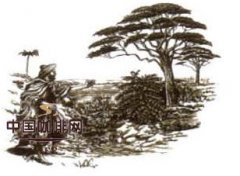When is the first peak period for the development of coffee planting industry in China?
By the end of the 1940s, according to recorded figures, there were 2173.33 hectares of rubber plantations on Hainan Island, with a total of 867600 rubber trees, with an annual output of 199,000 tons of dry rubber, more than 300,000 coffee plants and an annual output of 1 ton of coffee beans. According to a survey in the early 1950s, a large number of coffee was left in Fushan area of Chengmai County, with a total of 70,000 plants, including more than 40,000 plants in Daji Village and more than 10,000 plants in Fushan Farm (Hongguang Farm). According to a survey in 1954, there were more than 290000 "2" plants on the island. Coffee was introduced into Leizhou Peninsula around 1949. Chen Jingyao, an old returned overseas Chinese from Xuwen County, brought back some small Arabic seeds from Malaya, raised seedlings and planted them in Keng Tsai Village.

When the people's Republic of China was founded, there were all kinds of waste waiting for prosperity. This country, which has just emerged from the semi-feudal and semi-colonial state and successive years of war, has entered a comprehensive social transformation: economy, politics, culture, ideas, and mode of production have all changed, developed and innovated with the founding of the people's Republic of China. The positive, scientific and progressive things grow up in the confrontation with the negative, ignorant and backward things. In order to consolidate the new regime, enhance the people's sense of identity with the new democratic politics, and accelerate the completion of social change, the first generation of central collective leadership represented by Mao Zedong is leading the people of all ethnic groups throughout the country to strive to restore the national economy. After the founding of the people's Republic of China, the cause of land reclamation in Guangdong is a brand-new cause developed by state investment and reclamation, construction and management on state-owned land. Party and state leaders are very concerned about the cause of land reclamation. Liu Shaoqi, Zhou Enlai, Zhu de, Chen Yun, Deng Xiaoping, Dong Biwu, Chen Yi, Liu Bocheng, Ye Jianying, Deng Zihui, Guo Moruo and Wang Zhen have visited the reclamation area and are concerned about the development of the coffee industry. In 1952, Taiyang River Coffee Factory, the first coffee monopoly manufacturer in New China, was established at the overseas Chinese Farm in Xinglong Town, Wanning County, Hainan Province.
The development of coffee planting in Guangdong land reclamation began in 1954. Based on the original coffee tree, carefully select seeds for reproduction. In 1955, 127.47 hectares of coffee were planted in the state-owned reclamation farms in Hainan reclamation area. In 1956, the South China Reclamation Bureau applied to the state for foreign exchange and imported a total of 581.6 kilograms of coffee seeds from Indonesia and Malaya. The seeds were distributed to Hainan Reclamation Bureau, Western Guangdong Reclamation Bureau, Hepu Office, Yantang Reclamation Farm, South China Subtropical crop Science Research Institute and county demonstration farms. In the four years from 1956 to 1959, a total of 1426.67 hectares of coffee were planted. There are 55 farms (stations) for growing coffee (including trial planting), including 33 farms (stations) in Hainan Reclamation area, with 906.67 hectares of coffee growing, and 22 farms (stations) in western Guangdong Province, planting (including trial planting) coffee 520 hectares. A total of 53.7 tons of dry coffee beans were produced in these four years. This is the first exuberant period for the development of coffee farming in Guangdong.
In order to meet the needs of Eastern European countries and the Soviet Union in the 1950s, Yunnan Province promoted the development of Lujiangba coffee in Baoshan City, making Lujiangba the first small seed coffee production base in the country. At present (1994), this batch of original species is still the leading variety of small seed coffee in Yunnan, with an area of 2666.67 hectares, of course, its original mother plant no longer exists. However, judging from the current situation of planting in the field, the variety structure of Tiebi accounted for 83.6%, and the wave band accounted for 16.4%. At present, this batch of original seeds not only provide the demand for planting in the province, but also provide planting in Hainan, Guangdong and other places, but also continue to provide corresponding cultivation technical data. In this way, Lujiangba in Baoshan City has become the scientific research center and birthplace of small seed coffee in China, which has played a positive role in coffee production.
Full record of early trial and expansion of Yunnan Agricultural Coffee (1955-1980)
Serial number
Unit
Trial planting age
Trial planting area (ha)
Planting age
Planting area (ha)
Harvest time
Output (tons)
Remarks
one
Dehong Branch Test Station
1956
8.2
1961
458.6
1961
34.6
two
State-owned Lujiang Farm
1955
Unknown
1959
one hundred
1984
454.6
The yield per hectare is 2854.05 kg.
three
State-owned New Town Youth Farm
1956
0.97
1957
15.4
1960-
1985
307.33
The yield per hectare is 5692.5 kg.
four
State-owned Shuangjiang Farm
1956
10.47
1956
10.47
Unknown
Unknown
All replanted in 1975
five
State-run Chaofang farm
1956
53.33
1961
eighty-four
1985
1.52
The production area is 13.73 hectares.
six
State-owned Hekou Farm
1955
0.51
1985
4.47
0.43
seven
State-owned Jinghong Farm
1958
Unknown
1979
246.67
Unknown
eight
State-run olive dam farm
Unknown
Unknown
Unknown
Unknown
Unknown
nine
State-owned Kumachi Farm
-
-
1960
Unknown
-
-
ten
State-run Meng Provincial Farm
-
-
1959-1961
186.67
-
-
All scrapped in 1963
eleven
State-owned Tianbao farm
-
-
1959
84.93
Unknown
-
All scrapped in 1963
twelve
State-owned Babu Farm
1960
13.33
1980
2.28
1982-1985
67.28
thirteen
State-run health farm
1958
three hundred and twenty
1962
85.6
Unknown
-
All scrapped in 1961
fourteen
State-owned Simao Farm
-
-
1968
Unknown
-
-
fifteen
State-run Menglian Farm
1962
two
1985
two
sixteen
State-owned farming farm
-
-
1958
239.6
1961
1.94
Harvest area 22.67 hectares
seventeen
State-run Mengding Farm
-
-
1959
10.4
1985
47.69
Harvest area of 85.87 hectares
Yunnan Province began to develop coffee production in the mid-1950s, mainly planted in Shuangjiang Farm and Dehong Sub-Bureau Experimental Station in Lincang area, covering an area of 18.67 hectares, and also planted in small areas such as Chaofang, Hekou, Lujiang, Jinghong and Olive Dam. Because the local environment is suitable for coffee growth, since 1957, the farms have developed in a large area, and the first and most wonderful part in the history of Yunnan agricultural reclamation coffee planting has appeared. In 1960, the planting area of the whole reclamation area reached 2186.67 hectares, accounting for about 60% of the planting area of the province and about 4 "5" of the national cultivated area.
During the first peak period from 1952 to 1961, the coffee planting area in China was mainly in Hainan Island and Yunnan Province, with a total area of 5066.67 hectares, of which Hainan Island was 1426.67 hectares (cultivated variety is Robesta). Yunnan is 3644 hectares, of which 2186.67 hectares are cultivated in Yunnan, accounting for about 60%. The rural area of the province is 1457.33 hectares, accounting for about 40% (the cultivated variety is Arabika).
Important Notice :
前街咖啡 FrontStreet Coffee has moved to new addredd:
FrontStreet Coffee Address: 315,Donghua East Road,GuangZhou
Tel:020 38364473
- Prev

Coffee Culture Common Sense Coffee Spread History (I)
In 622 Muhammad, the prophet of Islam, led the pilgrimage of believers from Mecca to Medina, and began to establish a religious state, which developed into a powerful empire spanning Central Asia to Liberia in the next century. Ethiopia, the origin of coffee, was included in the Islamic Empire and maintained its independence as a Christian state. Coffee began to spread from Ethiopia to Afghanistan in the 10th and early 11th centuries.
- Next

Chinese coffee has experienced a low period of national macro-adjustment.
In August 1960, the CPC Central Committee put forward the eight-character policy of readjusting, consolidating, enriching, and improving, and once again stressed the need to shorten the capital construction front. It was only after the 7,000-member meeting was held in early 1962 that the Central Committee gradually agreed. In April 1962, after the Central Financial and Economic Group approved and transferred the report of the Central Financial and Economic Group on discussing the 1962 adjustment plan, it was only after the Central Committee of the Central Committee of Finance and Economics approved and transferred the report of the Central Financial and Economic Group on the discussion of the 1962 adjustment plan that the problem that the infrastructure front had been too long for many years was taken seriously.
Related
- How did the Salvadoran coffee industry develop in Central America?
- What exactly does the golden cup extraction of coffee mean?
- The Origin of Coffee flower
- [2023 Starbucks World Earth Day] there are more meaningful things besides free Starbucks coffee!
- What kind of coffee is there in Spain? 9 Flavors of Spanish Coffee
- Aromatic African coffee| Kenya's coffee culture and historical production area
- Liberica Coffee Bean knowledge: the characteristics of Liberian Coffee beans of the three original species of Coffee beans
- The origin and formula of Spanish latte introduces the taste characteristics of Bombon coffee in Valencia, Spain.
- How to adjust the solution of over-extracted coffee
- What is the tasting period of coffee beans? What is the period of coffee and beans? How should coffee wake up and raise beans?

